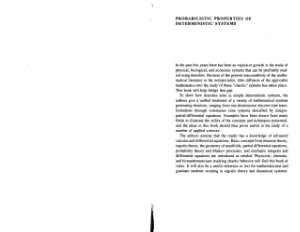Paperback: 372 pages
Publisher: Cambridge University Press; 1 edition (November 27, 2008)
Language: English
ISBN-10: 0521090962
ISBN-13: 978-0521090964
This book shows how densities arise in simple deterministic systems. There has been explosive growth in interest in physical, biological and economic systems that can be profitably studied using densities. Due to the inaccessibility of the mathematical literature there has been little diffusion of the applicable mathematics into the study of these 'chaotic' systems. This book will help to bridge that gap. The authors give a unified treatment of a variety of mathematical systems generating densities, ranging from one-dimensional discrete time transformations through continuous time systems described by integro-partial differential equations. They have drawn examples from many scientific fields to illustrate the utility of the techniques presented. The book assumes a knowledge of advanced calculus and differential equations, but basic concepts from measure theory, ergodic theory, the geometry of manifolds, partial differential equations, probability theory and Markov processes, and stochastic integrals and differential equations are introduced as needed.
Publisher: Cambridge University Press; 1 edition (November 27, 2008)
Language: English
ISBN-10: 0521090962
ISBN-13: 978-0521090964
This book shows how densities arise in simple deterministic systems. There has been explosive growth in interest in physical, biological and economic systems that can be profitably studied using densities. Due to the inaccessibility of the mathematical literature there has been little diffusion of the applicable mathematics into the study of these 'chaotic' systems. This book will help to bridge that gap. The authors give a unified treatment of a variety of mathematical systems generating densities, ranging from one-dimensional discrete time transformations through continuous time systems described by integro-partial differential equations. They have drawn examples from many scientific fields to illustrate the utility of the techniques presented. The book assumes a knowledge of advanced calculus and differential equations, but basic concepts from measure theory, ergodic theory, the geometry of manifolds, partial differential equations, probability theory and Markov processes, and stochastic integrals and differential equations are introduced as needed.

